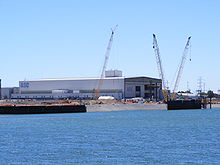- Collins class submarine replacement project
-
The Collins class submarine replacement project is a Royal Australian Navy (RAN) effort to replace the Navy's six Collins class submarines with 12 new Australian designed submarines from 2025. At an estimated cost of up to A$25 billion, the project may be the most expensive defence acquisition ever undertaken by the Australian Government.
In December 2007, the then Australian Minister for Defence, Joel Fitzgibbon, authorized the RAN to begin planning the project. A project office was established in October 2008 and the project was designated SEA 1000. In the 2009 Defence White Paper the Australian government confirmed its intention to double Australia's submarine force to 12 boats to keep pace with the increased number of submarines in Australia's region.[1]
Contents
Development
The Australian Government and Australian Defence Force (ADF) believe that the Royal Australian Navy's submarine service forms a vital component of the ADF and thus will double in size as countries in Australia's region expand or establish their own submarine forces.[2] The role of the new submarines will be to collect intelligence, attack ships, submarines and land targets with missiles and torpedoes and land special forces teams.[3] The submarines' capabilities will also act as a deterrent against military attacks on Australia.[4]
Due to the project's complexity it is expected that it will take 17 years to design the submarines, gain government approval for the project and complete the first boat in the class. The timeline for the project calls for research into the submarines begin in late 2007 or early 2008 and be completed by 2011 when the Federal Cabinet will give initial approval to the design. After the design is developed further it is planned that Cabinet will give final approval for the project in 2014 or 2015 after which contracts for the submarines will be signed and construction will begin. The sea trials for the first new submarine have been tentatively scheduled for 2024 so that the boat is ready to replace the first Collins class submarine which is scheduled to be decommissioned in 2025.[2] The project office which will oversee the development of the new submarine's design was established in October 2008 and is jointly administered by the Defence Materiel Organisation and the Department of Defence's Capability Development Group.[5]
The new class of submarines is expected to be a unique Australian design rather than a variant of an existing foreign design.[3] While the Navy's study will consider all submarine options, including the acquisition of nuclear powered submarines, it is expected that the final design will be a larger, quieter, faster and better armed version of the Collins class.[2] While the Government initially promised that the submarines would be built by ASC (formerly the Australian Submarine Corporation) in Adelaide, South Australia, in May 2009 it announced that ASC may have to bid against other companies though the submarines would still be built at Adelaide regardless of which company wins the tender.[6] ASC built all of the Collins class boats and operates the only submarine construction facility in Australia.[2] Building the boats in Australia may increase their cost, however.[7]
Proposed design features
While the submarines' design will not be finalised until after 2011, a range of features have been suggested.
Nuclear propulsion is likely to be ruled out because of cost and the lack of nuclear-power infrastructure. It is expected that the submarines will have an air-independent propulsion system that will allow them to remain underwater much longer than the Collins-class boats.[3] The submarines will also have state-of-the-art batteries and sophisticated communications.[8]
The new submarines are expected to be better armed than the Collins class, armed with long-range cruise missiles, which are not currently carried by the Collins class, as well as shorter ranged missiles and torpedoes. The new submarines may also carry midget submarines which will be used to collect intelligence or land special forces troops.[3]
Notes
- ^ http://www.defence.gov.au/whitepaper/ Australian Government Defence White Paper 2009 page: 70
- ^ a b c d Stewart, Cameron (2007-12-26). "Navy's new lethal subs". The Australian. http://www.theaustralian.news.com.au/story/0,25197,22971955-601,00.html. Retrieved 2007-12-26.
- ^ a b c d Stewart, Cameron (2007-12-29). "Defence to reach new depths". The Australian. http://www.theaustralian.news.com.au/story/0,25197,22981343-31477,00.html. Retrieved 2008-01-12.
- ^ "New subs unlikely to go nuclear: ADA". ABC News. 2007-12-26. http://www.abc.net.au/news/stories/2007/12/26/2127332.htm. Retrieved 2008-01-12.
- ^ "4.6m for next generation submarine study". ABC News. 2008-10-27. http://www.abc.net.au/news/stories/2008/10/27/2402521.htm. Retrieved 2008-10-27.
- ^ Owen, Michael; Akerman, Pia (5 May 2009). "Labor reneges on submarine promise to builder ASC". The Australian. http://www.theaustralian.news.com.au/story/0,25197,25430228-31477,00.html. Retrieved 5 May 2009.
- ^ Dodd, Mark (2008-01-07). "Navy cost sinking budget". The Australian. http://www.theaustralian.news.com.au/story/0,25197,23015232-31477,00.html. Retrieved 2008-01-12.
- ^ Walters (2006). Page 11.
References
- Davies, Andrew (2007) (PDF). The enemy below: Anti-submarine warfare in the ADF. Australian Strategic Policy Institute. http://www.aspi.org.au/publications/publication_details.aspx?ContentID=116&pubtype=10.
- Davies, Andrew (2008-02-11). "Keeping our heads below water". Opinion. ABC News. http://www.abc.net.au/news/stories/2008/02/11/2159131.htm. Retrieved 2008-02-10.
- Dodd, Mark (2008-01-07). "Navy cost sinking budget". The Australian. http://www.theaustralian.news.com.au/story/0,25197,23015232-31477,00.html. Retrieved 2008-01-12.
- Johnstone, Paul (2007). "SEA 5000 - Search for the next submarine". DefenceToday 6 (3): Pg 24–26. ISSN 14470446.
- Stewart, Cameron (2007-12-26). "Navy's new lethal subs". The Australian. http://www.theaustralian.news.com.au/story/0,25197,22971955-601,00.html. Retrieved 2007-12-26.
- Stewart, Cameron (2007-12-29). "Sub fleet should be doubled: Beazley". The Australian. http://www.theaustralian.news.com.au/story/0,25197,22982416-31477,00.html. Retrieved 2008-01-12.
- Stewart, Cameron (2007-12-29). "Defence to reach new depths". The Australian. http://www.theaustralian.news.com.au/story/0,25197,22981343-31477,00.html. Retrieved 2008-01-12.
- (PDF) Submission to the Australian Senate inquiry into naval shipbuilding in Australia. Parliament of Australia. 2006. http://www.aph.gov.au/Senate/committee/FADT_CTTE/shipping/submissions/sub03.pdf. Retrieved 2008-01-12.
- (PDF) A brief on the issues arising from consideration of the requirements for a future submarine capability for Australia. Submarine Institute of Australia. 2007. http://www.submarineinstitute.com/userfiles/File/07REP2150_Conclusions%20Regarding%20a%20Future%20Submarine%20Capability%20for%20Australia_1_04_07.pdf. Retrieved 2008-01-12.
- Walters, Patrick (2006) (PDF). Cutting Edge: The Collins experance. Australian Strategic Policy Institute. http://www.aspi.org.au/publications/publication_details.aspx?ContentID=86&pubtype=6.
Collins class replacement TBA

Collins class Oberon class Odin class J class E class Other submarines Bases and tenders Categories:- Submarines of the Royal Australian Navy
- Proposed ships
Wikimedia Foundation. 2010.

